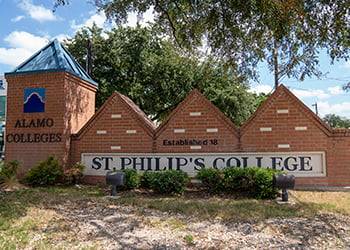Saint Artemisia Bowden
 |
AboutIn 1902, at twenty-three years of age, Artemisia Bowden traveled alone by train to San Antonio, Texas to lead St. Philip’s Normal and Industrial School. The bishop of the Episcopal Diocese of West Texas, Bishop James Steptoe Johnston, charged her with expanding and elevating the educational opportunities for African-Americans through the school. Because she had been a student of St. Athanasius, the Episcopal parish school in her native Brunswick, Georgia, and a 1900 graduate with teaching credentials from Saint Augustine’s School, also an Episcopal school in Raleigh, North Carolina, the bishop believed that she would be perfect for this mission. In 1935 her alma mater became St. Augustine’s College, and she was granted a Bachelor of Arts degree. She did graduate work during the summers at Columbia University, Cheyney State Teachers College, the New York School of Social Work, and the University of Colorado. In 1935 she received an honorary master’s degree from Wiley College and in 1952 she received an honorary doctorate from Tillotson College (now Huston-Tillotson University). Artemisia Bowden provided leadership for 52 years from 1902 – 1954. By 1928 St. Philip’s had achieved junior college status under Bowden’s leadership and by 1951 St. Philip’s College had also achieved full accreditation. Upon the unification of St. Philip’s College and San Antonio College into the San Antonio Union Junior College District in 1942, Bowden’s title was changed from president to dean and upon her retirement, she was named Dean Emeritus. Regardless of her title, Artemisia Bowden continued to provide leadership to St. Philip’s College and remained focused on her mission. She understood that the mission was greater than her title. |
|
Artemisia Bowden not only embraced challenges but stayed true to her vision and mission. History now shows that she laid the foundation for the growth and development that is now St. Philip’s College. She served as president of the San Antonio Metropolitan Council of Negro Women and was founder and president of the Negro Business and Professional Women’s Club. She was named to the Texas Commission on Interracial Relations in 1947. She is credited with being primarily responsible for the introduction of a Black nursing unit in Robert B. Green Hospital, for securing Lindbergh Park for Black residents, and for establishing the East End Settlement House. She is remembered in the community today in the naming of Artemisia Bowden Academy, the Bowden Chapter of Business and Professional Women, the Bowden Administration Building (now Bowden Building), Artemisia’s at St. Philip’s College, and the University of the Incarnate Word Bowden Eye Care and Health Institute. Artemisia Bowden was a humanitarian, educator, Christian, leader, advocate and fundraiser. She is known as the “Savior of St. Philip’s.” |
 |
Bowden Feast DaySaint Artemisia Bowden was canonized by the Episcopal Church in 2015. Her feast day is Aug. 18 on the Episcopal calendar. The same year she was elevated to sainthood, she was named President Emeritus by the Alamo Colleges District in recognition of her leadership and service to SPC. |
Artemisia Bowden PlaySt. Philip's College hosts a stage performance about Saint Artemisia Bowden's historical journey to San Antonio and becoming the first African American, woman leader of St. Philip's College. By 1928 St. Philip’s had achieved junior college status under Bowden’s leadership. |
Artemisia Bowden on KLRNSan Antonio's KLRN featured a segment on Saint Artemisia Bowden, "Women who Shaped San Antonio". Dr. Adena Wiliams Loston, SPC 14th President contribute to the segment speaking about the history and dedication that Saint Bowden provided to make St. Philip's College one of the largest HBCUs in the nation. |







